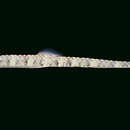Diagnostic Description
provided by Fishbase
Fine lines on the head and series of spots over the back and along trunk; caudal fin mainly pink (Ref. 48635).Description: Characterized by rings 16 - 17 + 33 - 35; 10 caudal rays; discontinuous superior trunk and tail ridges; straight lateral trunk ridge, ends near anal ring; continuous inferior trunk and tail ridges; length of snout 1.9-2.4 in head length; depth of snout 3.8-8.0 in snout length; head length 6.3-9.4 in SL (Ref. 90102).
- Recorder
- Cristina V. Garilao
Life Cycle
provided by Fishbase
Monogamous mating is observed as both obligate and genetic (Ref. 52884). Male carries the eggs in a brood pouch (Ref. 205).
Morphology
provided by Fishbase
Dorsal spines (total): 0; Dorsal soft rays (total): 23 - 33; Analsoft rays: 4
- Recorder
- Cristina V. Garilao
Trophic Strategy
provided by Fishbase
Found in inshore waters (Ref. 75154).
Biology
provided by Fishbase
Adults inhabit shallow protected areas of rubble and sand (Ref. 37816), usually semi-silty zones (Ref. 48635). Occur more commonly at depths between 0 and 3 m. Ovoviviparous (Ref. 205). Males carry the eggs in a brood pouch which is found under the tail (Ref. 205). Males may be brooding at 9.0 cm SL. Adults nearly always in pairs (Ref. 48635). Solitary, pairs or in small groups (Ref 90102).
- Recorder
- Estelita Emily Capuli
Importance
provided by Fishbase
fisheries: of no interest; aquarium: commercial
- Recorder
- Estelita Emily Capuli
分布
provided by The Fish Database of Taiwan
分布於印度-太平洋區,由東非到萬那度,北至日本南部。臺灣發現於南部。
利用
provided by The Fish Database of Taiwan
小型魚類,偶為潛水捕獲,除學術研究及水族觀賞外,不具食用價值。
描述
provided by The Fish Database of Taiwan
體特別的延長和纖細,無鱗,由一系列的骨環所組成;軀幹部的上側稜與尾部上側稜不相連接,下側稜則與尾部下側稜相接,中側稜平直而終止於臀部骨環處。吻長,頭長為其2.0-2.1倍;吻部背中稜低位或僅留痕跡。主鰓蓋具一完全的中縱稜。體環不具縱棘;無皮瓣。骨環
16-18 + 32-37;背鰭鰭條數 23-33;胸鰭鰭條數
13-18;尾鰭鰭條數10。體呈淡灰色,頭部及體側具甚多不規則線紋且交措成網狀;管狀吻、體背部稜棘及尾鰭呈橘紅色。
棲地
provided by The Fish Database of Taiwan
主要棲息於水淺且有遮蔽的碎石與泥沙混名區域,通常半淤泥的區域。生存深度通常介於
0 與 3 公尺之間。雄性在標準體長 9.0
公分時可以繁殖孵卵。 幾乎總是成對的成魚一起生活。
Messmate pipefish
provided by wikipedia EN
The messmate pipefish (Corythoichthys haematopterus) is a species of marine fish in the family Syngnathidae. It is widespread throughout the tropical waters of the Indo-Pacific region, from the eastern coast of Africa to the Vanuatu Islands. This species can reach a length of 19.8 cm.[2] It occasionally makes its way into the aquarium trade where it is known as the dragonfaced pipefish.[3] Other common names are bloodspot pipefish, reef pipefish, reeftop pipefish and yellow-streaked pipefish.[1]
The messmate pipefish exhibits biofluorescence, that is, when illuminated by blue or ultraviolet light, it re-emits it as yellow, and appears differently than under white light illumination. Biofluorescence may assist in intraspecific communication and camouflage.[4]
References
-
^ a b Gillespie, K.; Pollom, R. (2016). "Corythoichthys haematopterus". IUCN Red List of Threatened Species. 2016: e.T46102624A46665234. doi:10.2305/IUCN.UK.2016-1.RLTS.T46102624A46665234.en. Retrieved 19 November 2021.
-
^ a b Froese, Rainer; Pauly, Daniel (eds.) (2018). "Corythoichthys haematopterus" in FishBase. February 2018 version.
-
^ Saltwater Aquarium Fish for Marine Reef Aquariums: Dragonface Pipefish. Liveaquaria.com. Retrieved on 2016-12-06.
-
^ Sparks, John S.; Schelly, Robert C.; Smith, W. Leo; Davis, Matthew P.; Tchernov, Dan; Pieribone, Vincent A.; Gruber, David F. (2014). "The Covert World of Fish Biofluorescence: A Phylogenetically Widespread and Phenotypically Variable Phenomenon". PLOS ONE. 9 (1): e83259. Bibcode:2014PLoSO...983259S. doi:10.1371/journal.pone.0083259. PMC 3885428. PMID 24421880.

- license
- cc-by-sa-3.0
- copyright
- Wikipedia authors and editors
Messmate pipefish: Brief Summary
provided by wikipedia EN
The messmate pipefish (Corythoichthys haematopterus) is a species of marine fish in the family Syngnathidae. It is widespread throughout the tropical waters of the Indo-Pacific region, from the eastern coast of Africa to the Vanuatu Islands. This species can reach a length of 19.8 cm. It occasionally makes its way into the aquarium trade where it is known as the dragonfaced pipefish. Other common names are bloodspot pipefish, reef pipefish, reeftop pipefish and yellow-streaked pipefish.
The messmate pipefish exhibits biofluorescence, that is, when illuminated by blue or ultraviolet light, it re-emits it as yellow, and appears differently than under white light illumination. Biofluorescence may assist in intraspecific communication and camouflage.
- license
- cc-by-sa-3.0
- copyright
- Wikipedia authors and editors
Description
provided by World Register of Marine Species
Occurs more commonly at depths between 0 and 3 m. Males may be brooding at 9.0 cm SL.
Froese, R. & D. Pauly (Editors). (2023). FishBase. World Wide Web electronic publication. version (02/2023).
- license
- cc-by-4.0
- copyright
- WoRMS Editorial Board

